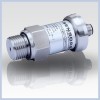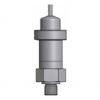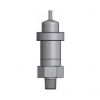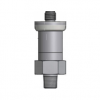Pressure sensors with Modbus communications protocol for connecting to a serial bus or a digital sensor network. Modbus communications protocol pressure sensors can be connected together with other Modbus enabled sensors to create a sensor network where each sensor has it’s own unique address which the master can use to identify a particular sensor in the network and measurement data.
Products
 DPT100 Modbus RTU RS485 Differential Pressure Sensor - The DPT 100 is a high-accuracy differential pressure transmitter designed for fast test processes in leakage and flow measurement applications where rapid response time and high sampling rates are essential
DPT100 Modbus RTU RS485 Differential Pressure Sensor - The DPT 100 is a high-accuracy differential pressure transmitter designed for fast test processes in leakage and flow measurement applications where rapid response time and high sampling rates are essential DCT 531 Modbus RTU RS485 Pressure Sensor - The DCT 531 digital pressure sensor has a Modbus RTU RS485 interface for transmitting pressure readings over a digital sensor network.
DCT 531 Modbus RTU RS485 Pressure Sensor - The DCT 531 digital pressure sensor has a Modbus RTU RS485 interface for transmitting pressure readings over a digital sensor network.
Applications
 Portable data acquisition trolley +/-20 kPa dp RS485 Modbus RTU interface air pressure sensor and display package - A digital display, pressure sensor and digital interface module package for use on portable data acquisition trolleys to measure pressure of air over a range of -20 to 20 kPa diff from two 6.6mm dia x 11mm barbed hose connections, and sending the corresponding reading via a RS485 Modbus RTU interface through the terminal block connector electrical connections.
Portable data acquisition trolley +/-20 kPa dp RS485 Modbus RTU interface air pressure sensor and display package - A digital display, pressure sensor and digital interface module package for use on portable data acquisition trolleys to measure pressure of air over a range of -20 to 20 kPa diff from two 6.6mm dia x 11mm barbed hose connections, and sending the corresponding reading via a RS485 Modbus RTU interface through the terminal block connector electrical connections. -1 to 6 bar differential RS485 Modbus RTU freshwater pressure sensor for farming use on a 6bar line - A compound range differential pressure sensor for farming use to measure pressure of freshwater over a range of -1 to 6 bar diff on a 6 bar freshwater line from two G1/4 male process connections, and sending the corresponding RS485 Modbus RTU signal through the M12 connector electrical connection.
-1 to 6 bar differential RS485 Modbus RTU freshwater pressure sensor for farming use on a 6bar line - A compound range differential pressure sensor for farming use to measure pressure of freshwater over a range of -1 to 6 bar diff on a 6 bar freshwater line from two G1/4 male process connections, and sending the corresponding RS485 Modbus RTU signal through the M12 connector electrical connection. 7.5 psig RS485 Modbus RTU digital pressure sensor for leak testing use - A fine resolution digital pressure sensor for leak testing use to measure pressure of dried air or nitrogen in sealed steel tanks over a range of 0 to 7.5 psi g from the G1/4 male process connection, and sending the corresponding RS485 Modbus RTU signal through the weatherproof cable electrical connection.
7.5 psig RS485 Modbus RTU digital pressure sensor for leak testing use - A fine resolution digital pressure sensor for leak testing use to measure pressure of dried air or nitrogen in sealed steel tanks over a range of 0 to 7.5 psi g from the G1/4 male process connection, and sending the corresponding RS485 Modbus RTU signal through the weatherproof cable electrical connection. 150 psig RS485 Modbus RTU chilled water pressure sensor for supply and return monitoring - A digital interface pressure sensor for flow monitoring use to measure pressure of chilled water supply & return over a range of 0 to 150 psi g from the 1/4 NPT male process connection, and sending the corresponding RS485 Modbus RTU protocol interface through the weatherproof cable electrical connection.
150 psig RS485 Modbus RTU chilled water pressure sensor for supply and return monitoring - A digital interface pressure sensor for flow monitoring use to measure pressure of chilled water supply & return over a range of 0 to 150 psi g from the 1/4 NPT male process connection, and sending the corresponding RS485 Modbus RTU protocol interface through the weatherproof cable electrical connection.
 15 psi absolute range RS485 Modbus RTU protocol interface vacuum sensor for research use
15 psi absolute range RS485 Modbus RTU protocol interface vacuum sensor for research use 2.5 barg RS485 Modbus RTU interface air pressure transducer for production test automation use
2.5 barg RS485 Modbus RTU interface air pressure transducer for production test automation use 60 barg range RS485 Modbus RTU seawater pressure sensor for flow control use
60 barg range RS485 Modbus RTU seawater pressure sensor for flow control use 10 barg range RS485 Modbus RTU air pressure sensor for flow control use
10 barg range RS485 Modbus RTU air pressure sensor for flow control use Gas sensors testing barometric pressure sensor with RS485 Modbus RTU interface
Gas sensors testing barometric pressure sensor with RS485 Modbus RTU interface Modbus air pressure transducer for logging 10bar compressor
Modbus air pressure transducer for logging 10bar compressor
